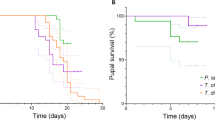Abstract
Cotesia glomerata parasitizes early instars of the cabbage butterfly,Pieris rapae, in Japan. Female wasps antennatedRorippa indica leaves damaged by feeding ofP. rapae larva, but ignored artificially damaged leaves. Females also antennated filter paper containingR. indica leaf juice plusP. rapae regurgitant. Chemical analysis revealed five compounds in higher amounts in the infested edges of leaves than in artificially damaged edges. Among them, we identified palmitic acid, oleic acid, and stearic acid. Female wasps antennated filter paper containing each of these three acids. We discuss the function of these acids in the tritrophic context.
Similar content being viewed by others
REFERENCES
DICKE, M. 1994. Local and systemic production of volatile herbivore-induced terpenoids: Their role in plant-carnivore mutualism.J. Plant Physiol. 143:465–472.
DICKE, M.,VAN BEEK, T. A.,POSTHUMUS, M. A.,BEN DOM, N.,VAN BOKHOVEN, H., andDE GROOT, Æ. 1990. Isolation and identification of a volatile kairomone that effects acarine predator-prey interactions: Involvement of host plant in its production.J. Chem. Ecol. 16:381–396.
GABEL, B., andTHIÉRY, D. 1996. Oviposition response ofLobsia botrana females to long-chain free fatty acids and esters from its eggs.J. Chem. Ecol. 22:161–171.
GEERVLIET, J. B. F.,VET, L. E. M., andDICKE, M. 1994. Volatiles from damaged plants as major cues in long-range host-searching by the specialist parasitoidCotesia rubecula.Entomol. Exp. Appl. 73:289–297.
HIBBARD, B. E.,BERNKLAU, E. J., andBJOSTAD, L. B. 1994. Long-chain free fatty acids: Semiochemicals for host location by western corn rootworm larvae.J. Chem. Ecol. 20:3335–3344.
HWANG, Y.-S.,SCHULTS, G. W., andMULLA, M. S. 1984. Structure-activity relationship of unsaturated fatty acids as mosquito ovipositional repellents.J. Chem. Ecol. 10:145–151.
LE CONTE, Y.,ARNORD, G.,TROUILLER, J.,MASSON, C.,CHAPPE, B., andOURISSON, G. 1989. Attraction of the parasitic miteVarroa to the drone larvae of honey bees by simple aliphatic esters.Science 245:638–639.
MATTIACCI, L., andDICKE, M. 1995. Host-age discrimination during host location byCotesia glomerata, a larval parasitoid ofPieris brassicae.Entomol. Exp. Appl. 76:37–48.
MATTIACCI, L.,DICKE, M., andPOSTHUMUS, M. A. 1994. Induction of parasitoid attracting synomone in Brussels sprouts plants by feeding ofPieris brassicae larvae: Role of mechanical damage and herbivore elicitor.J. Chem. Ecol. 20:2229–2247.
RICKLI, M. 1992. Palmitic acid released from honeybee worker larvae attracts the parasitic miteVarroa jacobsoni on a servosphere.Naturwissenshaften 79:320–322.
SATO, Y. 1979. Experimental studies on parasitization byApanteles glomeratus. V. Factors leading a female to the host.Physiol. Entomol. 4:63–70.
SATO, Y. 1988. The World of Parasitic Wasps. Tokai University Press, Tokai (in Japanese).
SHIMODA, T.,TAKABAYASHI, J.,ASHIHARA, W. andTAKAFUJI, A. 1997. Response of the predatory insectScolothrips takahashii toward herbivore-induced plant synomone under both laboratory and field conditions.J. Chem. Ecol. 23:(in press).
TAKABAYASHI, J., andDICKE, M. 1996. Plant-carnivore mutualism through herbivore-induced carnivore attractants.Trends Plant Sci. 1:109–113.
TAKABAYASHI, J.,DICKE, M., andPOSTHUMUS, M. A. 1991. Induction of indirect defense against spider-mites in uninfested Lima bean leaves.Phytochemistry 30:1459–1462.
TAKABAYASHI, J.,DICKE, M.,TAKAHASHI, S., andPOSTHUMUS, M. A. 1994a. Leaf age affects composition of herbivore-induced synomones and attraction of predatory mites.J. Chem. Ecol. 20:373–386.
TAKABAYASHI, J.,DICKE, M., andPOSTHUMUS, M. A. 1994b. Volatile herbivore-induced terpenoids in plant-mite interactions: variation caused by biotic and abiotic factors.J. Chem. Ecol. 20:1329–1354.
TAKABAYASHI, J.,DICKE, M.,TAKAHASHI, S., andPOSTHUMUS, M. A. 1995. Effect of the developmental stage of the herbivore on the production of herbivore-induced synomone.J. Chem. Ecol. 21:273–287.
THIÉRY, D., andGABEL, B. 1993. Inter-specific avoidance of egg-associated semiochemicals in four tortricids.Experientia 49:998–1001.
THIÉRY, D.,GABEL, B.,FARKAS, P., andJARRY, M. 1995. Egg dispersion in codling moth: Influence of egg extract and of its fatty acid constituents.J. Chem. Ecol. 21:2015–2026.
TROUILLER, J.,ARNOLD, G.,CHAPPE, B.,LE CONTE, Y., andMASSON, C. 1992. Semiochemical basis of infestation of honey bee brood byVarroa jacobsoni.J. Chem. Ecol. 18:2041–2053.
TURLINGS, T. C. J.,TUMLINSON, J. H.,HEATH, R. R.,PROVEAUX, A. T., andDOOLITTLE, R. E. 1991. Isolation and identification of allelochemicals that attract the larval parasitoid,Cotesia marginiventris (Cresson), to the microhabitat of one of its hosts.J. Chem. Ecol. 17:2235–2251.
TURLINGS, T. C. J.,WÄCKERS, F. L.,VET, L. E. M.,LEWIS, W. J., andTUMLINSON, J. H. 1993. Learning host-finding cues by hymenopterous parasitoids, pp. 51–78,in D. R. Papaj and A. C. Lewis (eds.). Insect Learning. Chapman & Hall, New York.
VET, L. E. M., andDICKE, M. 1992. Ecology of infochemical use by natural enemies in a tritrophic context.Annu. Rev. Entomol. 37:141–172.
WHITMAN, D. W. 1988. Allelochemical interactions among plants, herbivores and their predators, pp. 11–64,in P. Barbosa and D. K. Letoumeau (eds.). Novel Aspects of Insect-plant Interactions. Wiley Interscience, New York.
WHITMAN, D. W., andELLER, F. J. 1990. Parasitic wasps orient to green leaf volatiles.Chemoecology 1:69–75.
Author information
Authors and Affiliations
Rights and permissions
About this article
Cite this article
Horikoshi, M., Takabayashi, J., Yano, S. et al. Cotesia glomerata Female Wasps Use Fatty Acids from Plant–Herbivore Complex in Host Searching. J Chem Ecol 23, 1505–1515 (1997). https://doi.org/10.1023/B:JOEC.0000006418.49537.5d
Issue Date:
DOI: https://doi.org/10.1023/B:JOEC.0000006418.49537.5d




